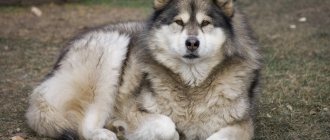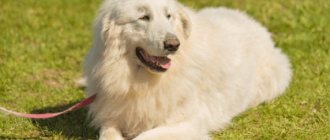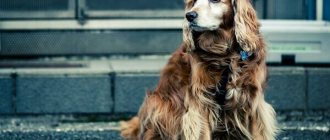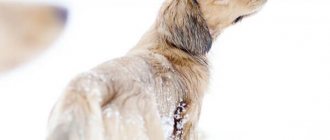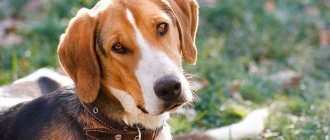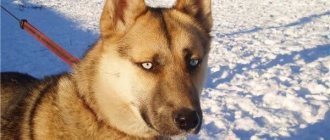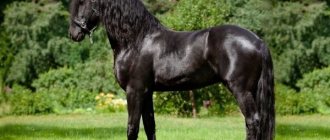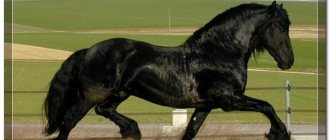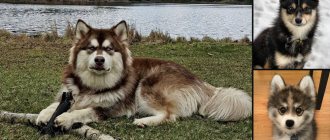- Pets
- >>
- Dog breeds
* Here is a photo of a typical representative of the Pyrenean mountain dog breed . You can send us photos of your animals by email, and we will post them on the website. Don't forget to send your pet's name.
Video
* We invite you to watch a video about the Pyrenean Mountain Dog . In fact, in front of you is a playlist in which you can select and watch any of 20 videos about a given dog breed by simply clicking on the button in the upper right corner of the window. In addition, the material contains quite a lot of photos. By looking at them you can find out what a Pyrenees Mountain Dog looks like.
In this article:
|
Price and where to buy
The cost of purebred puppies of this breed can be prohibitive: from $3,000 for a purebred puppy, but even in France there are many fake puppies on message boards that have nothing to do with the Alpine Shepherd. Puppies without the appropriate documents are sold at prices starting from $150. In Russia, such lots appear infrequently, since in the CIS countries no one is breeding this breed.
Each owner of Alpine Shepherd puppies must have supporting documents from l'Association de berger de Savoie signed by the President of the Line Perrier organization.
History of the origin of the Pyrenean mountain dogs
This breed of dog was bred to protect houses and livestock in mountainous areas, and in terms of its qualities, Pyrenean mountain dogs can compete with breeds such as the Central Asian Shepherd Dog or Tibetan Mastiff. Thick fur protects these dogs from the cold and bites of large predators, which they were excellent at dealing with. Due to their endurance, these dogs were also used as carrier animals.
How these dogs got into the Pyrenees Mountains is still unknown. Some experts believe that the Pyrenean mountain dog is one of the oldest breeds that arose in Europe back in 1800 BC, and maybe earlier. There is also an opinion that the dog originates from Asia, where the breed was formed.
Interesting fact: The Pyrenean Mountain Dog was highly valued not only by peasants, who used it to herd animals and protect property. These dogs were also appreciated by rich people, who placed such dogs to guard rich mansions. In 1675, this dog breed even received official recognition among the courtiers.
Only towards the end of the 19th century did Pyrenean dogs come to America, where they received the well-deserved attention of many breeders. From there, the story of the growing popularity of this breed began: in the 20th century, the first exhibitions began to be held. During the First and Second World Wars, Pyrenean dogs provided significant assistance to soldiers, dragging the wounded from the battlefield and transporting valuable ammunition and cargo.
In the 20th century, serious work was underway to restore the Pyrenean dog breed. Today, their numbers are stable, and they continue to be popular among breeders.
History of the breed
Originally Alpine, they are also called Savoy, shepherd dogs lived away from humans .
But later, some individuals were domesticated and loved by many people for their devotion to the owner. But they took root best of all among the shepherds. Dogs have enormous strength, this gives them the opportunity to command the herd; at one time in the Alps they were the only dogs that helped in shepherding.
But gradually there were fewer and fewer Savoy Shepherds, this was due to the fact that a large number of dogs of other breeds were brought.
Alpine Shepherds were on the verge of extinction, but in a village remote from the Alps, people discovered several puppies of this breed, and from that day on, not only breed lovers, but also scientists began to restore the species.
Today the breed is not considered widespread, these dogs rarely participate in exhibitions, and the breed is never recognized by canine organizations. There is now only an approximate unofficial standard created in 1960.
Pyrenean Mountain Dog - description of the breed
Pyrenean mountain dogs are similar in appearance to wolf-like dogs of ancient breeds. For centuries, people have selected the largest puppies with the lightest fur so that it would be visible among dense vegetation. Also, white dogs were different from wolves, so shepherds did not confuse dogs with predators in the dark, and could also shoot wolves during a fight with a dog.
Pyrenean dogs have a large body and high height - from 75 cm. The weight of such dogs can reach 55 kg, but the dog does not look bulky. These dogs are quite elegant and easy to walk.
According to the standard, dogs should have a round skull, not massive, with a pronounced occiput. The length of the skull should be equal to the muzzle. The muzzle is wedge-shaped, the transition to the forehead is smooth, without a clear bend. These dogs have almost no brow ridges and cheekbones, and their cheeks are almost unpronounced.
The eyes of the Pyrenees Mountain Dog are small, almond-shaped and wide set. The color of the iris can be all shades of brown, up to almost black. The eyelids cover the eyeball well, but are not clearly expressed due to the dark color. Thanks to this, the dog’s gaze is considered conscious and attentive.
Pyrenees dogs have small, triangular-shaped ears that are set quite low. The tips of the ears are not sharp, but rounded, reaching the corners of the eyes. The fur on the top and bottom of the muzzle forms a convergence that extends to the base of the ear.
These dogs have a scissor or straight bite. Strong white teeth slightly tilted inward. The lips tightly cover the teeth and are black in color, as is the nose. The elongated body of such dogs looks overly elongated, more in length than in height. Pyrenean dogs have a straight, strong back with a low tail and a pronounced croup. The paws are strong, the joints are visible.
Popular colors of Pyrenees mountain dogs
The coat of the Pyrenees Mountain Dog is unique in its structure. Below there is a thick undercoat, dense, but very soft, pleasant to the touch. It is not long, so it is completely covered with a top layer of wool. The guard hair is straight, sometimes curls a little, but not curly.
The top layer of hair is very long and hard. The thick fur on the back of the hind legs forms something similar to pants, and a headband resembling a lion's mane grows around the neck. The tail is also covered with long hair, which becomes shorter towards the end. The muzzle and ears are covered with a smooth short coat. The thick coat of the Pyrenees Mountain Dog is self-cleaning, making this breed easy to keep.
Colors of the Pyrenean Mountain Dog:
- The most popular color is snow white. It is he who is valued among breeders as the most noble. Dogs with snow-white fur have the greatest chance of winning at a show;
- Colors with fawn and light beige spots on the body are allowed. The spots must be very large and barely visible. They do not take up more than a third of the white space on the dog;
- Darker spots are not allowed by all cynological organizations, but they do occur. These are light gray, reddish and badger spots that are located on the head or tail.
Coat and color
As stated in the description of the Mountain Pyrenees dog breed, their color should be light, or rather pure white. But the presence of fawn, red, brown and gray spots on the ears, tail and belly is still allowed. But there should be no black color on the body. As the breed description states, all shades except white should not occupy more than 1/3 of the entire body.
A pet's coat is considered special and unique. Its lower part is the down, which is delicate, thick and dense. The upper part of the fur is hard and long. Reviews from breeders and dog handlers show that the hair may be slightly crimped, but it should not turn into curls.
On the ears and muzzle of dogs, the fur is less long, but soft in comparison with the body. And the longest fur is on the neck, which gives the representatives of the breed an elegant and stately appearance.
Character and habits of Pyrenean mountain dogs
Pyrenean mountain dogs are distinguished by exclusively positive qualities: kindness, patience, sharp intelligence and devotion to their owners. These large dogs have not lost their guarding qualities and still show a penchant for herding work. Despite this, Pyrenean dogs are excellent companions.
These dogs, due to their patience, love children, allowing them to ride on their backs. Even adult dogs can support children in playing with them, but at the same time they will not allow the child to get into trouble by vigilantly monitoring his movements. Pyrenean dogs are even used for the psychological rehabilitation of children who have developmental disorders.
Dogs also get along well with other pets, including cats. A well-mannered and intelligent dog will never touch someone who does not interfere with him or his owners. They do not show unreasonable aggression, on the contrary, demonstrating a balanced character. But due to their protective qualities, these dogs are always wary of strangers.
Interesting fact: When a stranger comes to visit, these dogs show increased interest in him, trying to sniff him. This way the dog makes sure that the stranger is not a threat to the owners, and then may even allow himself to be petted. But throughout the stay of strangers in the house, the dog will keep an eye on them.
Pyrenean dogs are good watchdogs. They faithfully guard the territory of the home and family members. The barking of these dogs and their menacing appearance can scare away any intruders. Although these dogs are not stubborn, they can sometimes show excessive independence, making decisions without the knowledge of their owners. For example, if a dog senses danger, he may leave the house to eliminate it.
In general, dogs are independent in making decisions, do not tolerate aggression towards themselves, but are ready to endure a lot from their owners.
How to choose the right puppy?
Pyrenees have up to 7 puppies in a litter, so choosing the right one can sometimes be very difficult.
To make the right choice, you must follow the following recommendations:
- Pay attention to the appearance of the animal; the baby should be well-fed, cheerful and playful.
- A responsible breeder will never give up a baby without vaccinations before the due date.
- Ask the breeder for documents and check show certificates.
- A purebred dog must have a full package of documents.
- Assess your puppy's legs for dysplasia.
Interesting facts about Pyrenees mountain dogs
The Pyrenean Mountain Dog breed dates back about four thousand years, and during this time the breed has acquired many interesting qualities. It is reliably known that dogs of this breed were companions of shepherds who lived on the border of France and Spain. There is even evidence from documents that these dogs lived next to ancient people.
Over its long history, the dog has distinguished itself by many facts:
- Pyrenean dogs can stay awake for a long time. Originally it was necessary for them to guard the herds at night, but now that guarding is no longer required, the dog still retains this quality;
- These dogs are considered the royal dogs of France. This is one of the few examples when a working peasant dog came into use by the nobles due to its irreplaceable qualities;
- Louis XIV declared these dogs royal because he loved this breed very much;
- Queen Victoria, who generally loved dogs, received a Pyrenean puppy as a gift;
- The Marquis de Lafayette brought Pyrenean Mountain Dogs from Europe to America back in 1824, and the breed has still been growing in popularity since then;
- During the Second World War, almost all representatives of the breed were destroyed. They were indispensable in transporting heavy ammunition along mountain paths among the Alps;
- The restoration of the breed began in the 20th century, and the largest part of it was farmers who preserved these dogs;
- Pyrenean dogs influenced the development of the Saint Bernard breed, which almost became extinct in an epidemic in 1870 in the Alps.
Main characteristics
| Breed parameters | |
| Country of origin: | France |
| Weight of the breed: | males: 50-54 kg, females: 36-41 kg |
| Height at withers: | males: 70-82 cm, females: 65-74 cm |
| Temperament: | calm |
| Wool: | long |
| Role in human life: | shepherd, watchdog, companion |
The Pyrenees are man's best friend and ideal companions for kids. Not a single intruder will pass by such a pet and even the fastest mouse will not run.
Pros and cons of Pyrenees mountain dogs
The Pyrenean Mountain Dog has a number of advantages over other breeds.
These include:
- Unquestioning devotion to the owner;
- Smart, good learning ability. Dogs of this breed love to serve people, so they are willing to train;
- Excellent security qualities. Pyrenean mountain dogs are natural guardians, and they will defend their territory to the end;
- These dogs are peaceful, so you don’t have to be afraid that they will show aggression towards people for no reason;
- Independence. Often they can be left to their own devices, and the dog will not feel discomfort from this. Also, in emergency situations, these dogs are able to make decisions independently.
But this breed of dog also has a number of disadvantages. In addition to the enormous size, due to which the dog will not fit in the apartment.
These include:
- The need for proper training. A dog can be uncontrollable and dangerous if not handled;
- Careful care of the coat so that it does not get tangled;
- If a dog of this breed becomes aggressive, it will be difficult to retrain it;
- These dogs have only one leader, whose commands they will follow. Other people in the family are simply members of the pack;
- These dogs also need good and regular physical exercise.
Key points in training
The dog is not only large, but also very strong physically and in character. The Pyrenees choose the owner, the leader of the pack. They need a strong, confident owner who knows how to drive a car and not break down. The animal will not tolerate bullying or brute force. Therefore, learning should be based on mutual respect, strong friendship and mutual assistance. Commands are given to the puppies in a playful manner so that the activity is not monotonous and tedious.
If the dog requires certain skills in its work (for example, a service animal), it is necessary to invite a highly specialized specialist for training.
For information on how to properly train a dog, read the article: “Training a puppy: effective methods of dog handlers, we teach commands at home.”
For this breed it is especially important to start training as early as possible. It is almost impossible to train an adult Pyrenean. As pets age, they become really stubborn. Therefore, from 2 months, children are explained in detail all the rules of behavior at home and on the street.
From childhood, puppies are taught watering and other procedures. The dog's socialization also begins during this period: getting to know other pets, people, and the environment.
If an animal is kept on a leash, it will become nervous, irritable, aggressive, or escape from the pen.
Breeding Pyrenean Mountain Dogs
Breeding a Pyrenees Mountain Dog is a complex undertaking that requires strict rules. This is the only way to obtain viable offspring that comply with the standard. To breed this breed, you should first obtain advice from specialists who have already done this. Choose reputable breeders.
A male who is ready for mating must be in excellent physical shape. The dog must be exposed to physical activity, eat properly, and have high muscle mass. Males are selected for their size, as well as for their character traits: calmness, poise, and obedience are important.
The first mating of a bitch should not occur earlier than the age of two. She must go through at least three heats - only then the dog is ready to bear offspring and subsequent births. An immature dog’s body can lead to the death of puppies and the adult itself. Also, mating too early can affect the quality of the offspring. A bitch should not give birth more than once a year.
For breeding, choose an animal without hereditary diseases and with all the necessary vaccinations. All features of the breed must be expressed in both parents: elongated body, narrow head, low-set tail, etc. It is better to introduce the bitch and the dog to each other in advance so that they do not get nervous when they meet.
Education and training
Previously, Pyrenean helpers were not trained at all, relying only on their innate instincts. However, this does not mean that they are not capable of training or do not absorb new knowledge well.
The main difficulty in raising such animals is the desire for autonomy and independence. At the same time, they are very understanding and obedient. As a rule, such pets understand from the first time what is wanted from them and do everything flawlessly.
Of course, due to their innate independence, there are times when these comrades are not in a particular hurry, however, in the end they do everything right. The organization of the educational process should begin with self-discipline. It is important to understand here that these proud animals do not accept rude treatment, raised voices, and especially assault. Only when they sense something negative will they try to quickly retreat from the site and flatly refuse to do anything.
If the Pyrenees was your first animal and you do not have any training skills, then it is best to enlist the help of an experienced specialist. You can also read specialized literature or completely entrust the educational process to an instructor.
It is worth noting that these animals react with their voices to any suspicious sound. Therefore, it is very important from the first days of a puppy’s arrival in the house to learn how to control its barking. Using special shocking collars for these purposes is strictly prohibited, as you risk permanently falling in the eyes of your pet. In addition, this approach will definitely not make them completely silent.
Since these individuals mature late, the learning process is often delayed. Natural stubbornness also plays an important role in this. It is important and necessary to constantly repeat the material covered and make sure that the dog has mastered it. It is recommended to use special treats as positive reinforcement. In addition, do not skimp on kind and encouraging words.
Mastering several commands at the same time is absolutely useless. With this approach, the pet begins to get confused and does not understand what is expected of him. Also, you should not modify the commands; if you have already started saying “Come to me!”, then the words “here”, “came up”, etc. will be confusing.
Caring for Pyrenean Mountain Dogs
Dogs of this breed do not require special care, but in order for their thick and long coat to look well-groomed and beautiful, they need to be looked after. Ideally, the dog should be brushed every day, but some breeders do this two or three times a month if the dog lives outside year-round and performs official duties.
Important fact: During the shedding period, the dog is brushed several times a day, otherwise there is a risk of getting hard tangles.
It is harmful to wash dogs too often - it dries out their skin and damages their coat. It is better to use special shampoos with a whitening effect, especially if the dog is a show specimen. With the help of such shampoos you can get rid of the yellowness that occurs with age around the eyes, on the paws and on the stomach. In fact, bathing is not difficult, since Pyrenean mountain dogs never refuse to swim.
The rest of the care is standard. It is necessary to brush your teeth, keep your eyes and ears clean, and trim your nails to prevent dirt from getting under them. Some breeders trim the hair under the tail to prevent it from getting dirty.
Care also includes the following classic procedures:
- Inspect the fur for ticks after a walk;
- Treatment for skin and internal parasites;
- Vaccination.
Content Features
Keeping a Pyrenean mountain dog in a city apartment or on a chain is not suitable. She needs space where she can run, a large territory that she will protect. It is not recommended to close the enclosure for a long time; communication with a person is advisable. Dog handlers recommend not limiting the freedom of this dog - it should be able to enter the house at any time.
Be sure to make a strong, high fence in the area where the Great Pyrenees lives. This dog can make a dig or jump over a low fence, and quickly understands how to lower the handle to open the gate. An insulated booth is also needed, where he can hide in hot weather or frost. You can let the dog into the house at night or leave it outside - they calmly tolerate it.
Even with this method of keeping, you need to walk your pet twice a day. It is advisable to take him to the dog park, where he can play and frolic. The Pyrenees will happily accompany its owner on runs or bike rides.
These dogs do not need special care. You need to check and wipe your pet’s ears every week and remove discharge from the eyes. Trim the nails approximately once a month, not forgetting the dewclaws.
Grooming
The coat of the Great Pyrenees requires careful grooming. It needs to be combed 3-4 times a week to prevent tangles from forming. Particular attention should be paid to areas behind the ears, abdomen, and limbs. During the molting period, this must be done daily. This dog sheds a lot, although only once a year.
For combing you will need combs with fine and rare teeth, brushes, a furminator, a slicker, and a tangle cutter. It is recommended to shorten the hair between the toes, in the groin, and under the tail. This will make it easier to keep clean.
The peculiarity of the coat of these dogs is that dirt does not stick to it, and it does not smell like a dog. Therefore, they do not need frequent washing, once every 2-3 months is enough. It is necessary to use a special shampoo for long-haired dogs. To maintain the whiteness of the coat, it is advisable to choose one that is designed for that color. Conditioners will also be needed to make combing easier. In summer you can bathe your dog in open water; Pyrenees love to swim.
Nutrition
You can feed this dog dry food or natural food. A puppy should eat 3-5 times a day, an adult dog - in the morning and evening. With natural feeding, at least 2/3 of the diet should be protein products. This is lean meat, sea fish, offal, eggs, cottage cheese. It is useful to give fermented milk products, cheese, herbs, and raw vegetables.
The meat can be mixed with a small amount of porridge - buckwheat, rice or oatmeal. Although veterinarians recommend giving porridge only in winter, when the dog needs more energy. You need to add vegetable oil, yeast, bran, fish oil, and vitamin complexes to your food.
Sweets, smoked foods, fatty and salty foods are prohibited for Pyrenean dogs. Potatoes, corn, and baked goods should not be given. Some foods can turn wool a rusty color. Veterinarians believe that this occurs due to the large amount of copper in the diet. Food allergies are also common, leading to dermatitis and brown spots under the eyes.
If you feed your pet dry food, you need to choose super-premium brands. They should be designed for giant breeds with average activity. The composition should have a high protein content and a minimum of carbohydrates. It is difficult for these dogs to choose the right food: they may be difficult to digest or may stain their coat. But many owners prefer this method of feeding, since it is easier to determine the amount of food and there is no need to give additional vitamins.
The Great Pyrenees should not be overfed, especially at an early age. These dogs have a slow metabolism, so weight accumulates quickly. Normally, the puppy's ribs should be clearly palpable. If you have excess body weight, there is a risk of developing pathologies of the musculoskeletal system. For an adult dog, the volume of food should be approximately 700-800 g at a time or 20 g per 1 kg of weight. But in determining the daily nutritional intake, you need to take into account the time of year, physical activity and the conditions under which the dog is kept.
It is recommended to feed your Pyrenean Shepherd after a walk. If the dog moves actively on a full stomach, he may experience intestinal volvulus. The bowl should be placed on a stand at chest level. The dog should always have clean water freely available.
Health
The Pyrenees Mountain Dog is adapted to work in harsh conditions. She is hardy, has good health, strong immunity. But all the same, the pet requires timely vaccination, deworming, and preventive examinations by a veterinarian. Life expectancy, like most large breeds, is about 12 years. With good care, these dogs live up to 15 years.
Sometimes the Pyrenees develop the following diseases:
- joint dysplasia;
- dermatitis;
- inflammation of the ears;
- volvulus;
- depression and nervous disorders when living in a confined space.
Diet of Pyrenees Mountain Dogs
Large dogs need the most nutritious and balanced food possible. These dogs are not picky about food, but the diet must be selected in accordance with natural food. Of course, premium ready-made food for large breeds is suitable, but homemade food is preferable for this breed. It should contain about 30 percent fat and carbohydrates, and 70 percent protein.
The diet of the Pyrenees Mountain Dog includes the following essential components:
- Raw meat. You can also serve it boiled, but occasionally – it is poorly digested by these dogs. It is worth giving preference to lean foods such as chicken, turkey, duck, rabbit, veal and lean lamb;
- Sea oily fish. It is strictly forbidden to give river water;
- A boiled egg is given two to three times a week, which gives dogs an important dose of protein and calcium;
- Lots of greens and vegetables: lettuce, cabbage, carrots, cucumbers. This will provide your mountain dog with fiber;
- Apples, pears, bananas, processed into puree, can be given once a week. Dried fruits are allowed as a treat;
- Kefir and low-fat dairy products: cottage cheese, cheese;
- Honey. It allows you to stabilize the digestive processes in the dog’s body.
The diet of puppies is different from that of adult dogs. It is important to provide plenty of fat and fiber so that the puppies grow strong and strong. Therefore, puppies also add fish oil, bran and brewer’s yeast to their general diet.
Feeding
Over the course of 3 years, the dog grows and matures. Moreover, a one-year-old puppy is larger in size than many large dogs, so special attention should be paid to the diet of the “highlander”. During puppyhood, a dog needs a larger volume of food compared to its own weight.
Professionals advise feeding growing active puppies natural food with a significant content of proteins and fats. They argue that, unlike in humans, fatty foods prevent the occurrence of cardiovascular pathologies inherent in large and giant breeds.
The entire volume of food corresponding to the puppy’s weight is divided into 2-4 feedings, and the food remaining in the bowls is removed after 20 minutes so as not to cause the development of juvenile obesity, which is typical for large dogs kept in a group.
Dogs should not be fed exclusively meat or offal. Animal foods contain a lot of phosphorus and little calcium. If there is a malnutrition, calcium begins to be “washed out” from the bones.
The dog's diet should include cereals and vegetables. Proper preparation of the daily diet when feeding dogs with natural food is difficult for a non-professional, so owners prefer to feed the Pyrenees with ready-made food.
They are balanced, but also require consideration of physical activity. Less active dogs are given less food. The feed is increased in winter and slightly reduced in summer. Clean water must be available in large quantities.
Diseases and health problems
This dog breed is incredibly healthy because dogs have been isolated from other breeds for thousands of years. They only crossed with each other, which is why they do not have genetic diseases. Harsh living conditions and hard work have made the Pyrenean mountain dog a very hardy, strong and healthy breed. However, there are a number of diseases that these dogs can be susceptible to under certain circumstances.
Hip dysplasia is a problem that any large breed owner can face. Excess weight and excessive exercise can cause your dog's back legs to become sore. She will begin to be reluctant to walk, limp, and over time may even stop walking altogether. Fortunately, modern veterinary medicine predicts this disease and successfully treats it.
Also, due to its large size, frequent paw dislocations and rickets are possible. Ear diseases, in particular otitis media, can occur due to insufficient ventilation of the ears, which fit tightly to the head. Therefore, your dog’s ears must be cleaned.
Important fact: Problems with the visual organs are not a common occurrence, but they do occur. Most often it is caused either by genetics, according to which the dog’s parents were ill, or by improper care.
Proper feeding, regular examination by veterinarians and timely diagnosis of diseases will help to avoid all these problems.
Breed diseases
All breeds have difficulties with well-being, including the Pyrenean breeds. I would like to note that the breed has health problems.
- Acute moist dermatitis - Pyrenees are prone to developing "hot spots" - isolated areas of the skin that suddenly become inflamed, infected and accompanied by hair loss, pain and self-destruction. They appear within a few hours and represent a serious local allergic reaction.
- Deafness. Some puppies have congenital deafness. The signs must be detected by the breeder before the puppies are ready for sale or rehoming.
- Demodicosis - Most mammals carry a significant population of Demodex mites in their skin pores throughout their lives. They are acquired by puppies when suckling from their mother, and the number of mites is controlled by the immune response. The Pyrenean dog is one of the breeds that is unable to respond adequately to these parasites and therefore suffers from itching, hair loss and skin infections. When puppies are affected, many of them eventually overcome this problem, but adult dogs with demodicosis require lifelong antiparasitic treatment.
- Ehlers-Danlos syndrome is a rare genetic disorder. It affects the connective tissues in the body and appears as inelastic, loose and brittle skin.
- Epilepsy - takes many forms, from a dramatic grandiose form with convulsive movements and loss of consciousness, to unattended spells or impulsive behavior (such as catching flies). The diagnosis of epilepsy is made after excluding other possible causes for these episodes. Dogs experiencing severe or frequent seizures require treatment.
- Factor VIII deficiency. It is an inherited disorder that is gender-linked. Its other name is hemophilia. Insufficient production of factor VIII leads to increased bleeding time after minor injuries. Males suffer from the disorder, while females are genetic carriers.
- Dilatation of the stomach - Volvulus - is a dramatic condition, this is a sudden accumulation of gases in the stomach due to a violation of their evacuation. As a result, the stomach swells to a significant size, puts strong pressure on the diaphragm, internal organs and great vessels, which causes disruption of breathing and blood supply and can lead to the death of the animal. Pyreneans are predisposed to this disease. Feed small meals several times during the day and avoid exercise for an hour after meals. These measures will help relieve the symptoms of the disease and prevent its development.
- Hemangiosarcoma is a malignant tumor of blood vessels. It most often occurs on the spleen, but also affects the heart and other organs. The symptoms are similar to internal bleeding, with collapse being the first sign of a problem.
- Hip dysplasia is a common cause of lameness in young large breed dogs and is characterized by abnormalities in the development of the growing hip joints. The incidence of this disease is decreasing due to the widespread implementation of hip evaluation schemes for breeding dogs because it is an inherited disease.
- Hygroma is swelling of tissues with saturation with serous fluid. It is formed against the background of chronic and repeated compression of tissue at the location of bone protrusions. This occurs on the lateral surface of the elbow, on the heel, back of the head, wrist and in the pelvic area. Often does not cause stress or pain to the dog and is managed by providing soft bedding to prevent pressure on these poorly protected areas.
- Hypothyroidism - The thyroid gland maintains a normal metabolic rate in the body. Thyroid disease, which results from immune-mediated damage, causes weight gain and skin changes and worsens seizure activity in dogs with epilepsy. The disease is treated after a correct diagnosis is made.
- Lupoid Onychodystrophy - This is seen in adult Pyrenees as the growth of brittle or abnormal nails and occurs when there is inflammation in the nail bed where the growth originates. This condition results in significant pain and requires a combination of steroids, antibiotics and mineral supplements for optimal treatment.
- Pannus is an inflammatory condition where immune cells invade the clear surface of the eye and give it a red or pink color.
- Von Willebrand's Disease - Another blood clotting disorder (see factor VIII deficiency) seen in the breed, this is caused by a disorder of platelet function. These dogs are one of several breeds tested for this condition even before minor surgical procedures.

